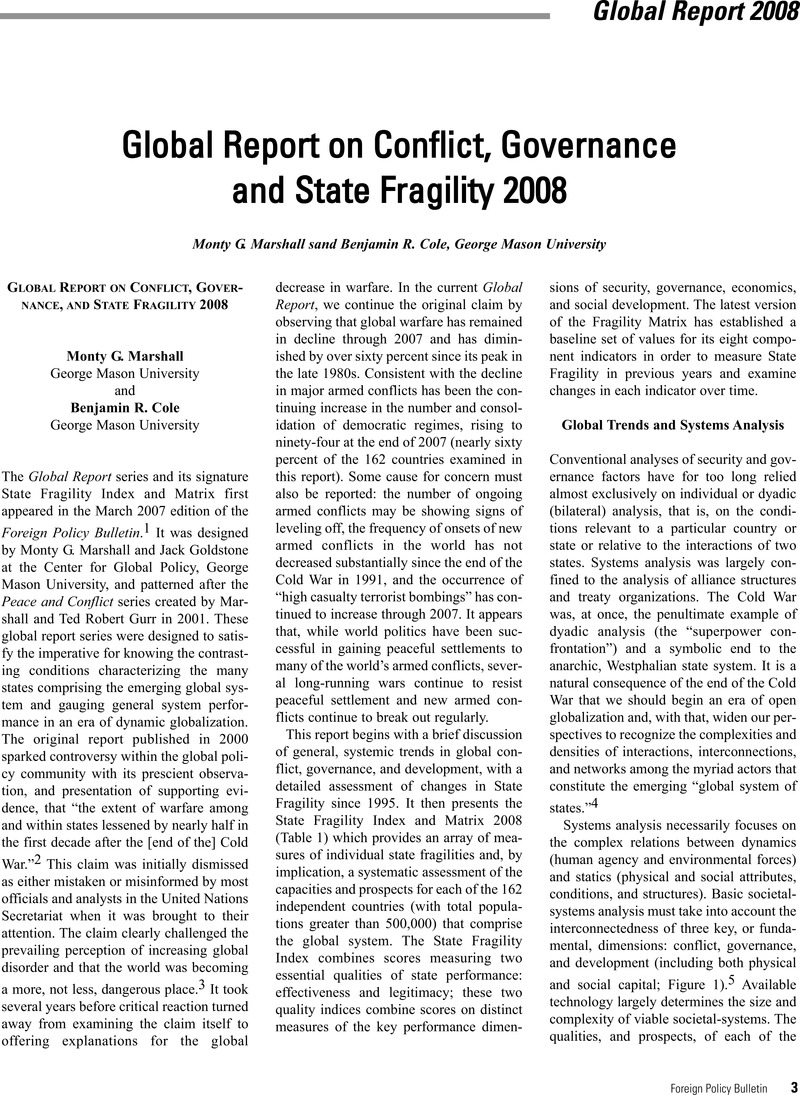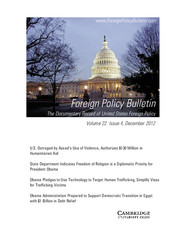Article contents
Global Report on Conflict, Governance and State Fragility 2008
Published online by Cambridge University Press: 01 January 2008
Abstract

- Type
- Research Article
- Information
- Copyright
- Copyright © Cambridge University Press 2008
References
1. The Global Report 2008 appears in the March 2008 issue of Foreign Policy Bulletin (Cambridge University Press); www.foreignpolicybulletin.com. The Report is prepared at the Center for Global Policy at George Mason University; globalpolicy.gmu.edu. The lead author can be contacted by email at mmarsha5@gmu.edu.
2. Ted Robert Gurr, Monty G. Marshall, and Deepa Khosla, Peace and Conflict 2001: A Global Survey of Armed Conflicts, Self-Determination Movements, and Democracy (College Park, MD: Center for International Development and Conflict Management, 2000), p.9.
3. This general reaction was intimated by Andrew Mack who was heading the Secretary General's Strategy Unit at that time and who personally circulated our findings through UN channels.
4. Large portions of descriptive text in the “systems-analysis,” “governance,” and “armed conflict” sections have been carried over from last year's Global Report to provide basic information on how global trends have been measured and charted. See Monty G. Marshall and Jack Goldstone. 2007. “Global Report on Conflict, Governance, and State Fragility 2007: Gauging System Performance and Fragility in the Globalization Era.” Foreign Policy Bulletin 17.1 (Winter 2007):3-21.
5. See Monty G. Marshall, Third World War: System, Process, and Conflict Dynamics (Lanham, MD: Rowman & Littlefield, 1999) for a more detailed explanation of the societal-systems approach to political analysis.
6. The Polity IV data set was originally designed by Ted Robert Gurr and coded by Erica Klee Gurr and Keith Jaggers; the Polity IV Project is now directed by Monty G. Marshall at the Center for Global Policy (CGP), George Mason University, and the Center for Systemic Peace. It has annually coded information on the qualities of political institutions for all independent countries (not including microstates) from 1800 through 2006 and is updated annually by Marshall and Jaggers; the most recent year (2007) values have been estimated by Marshall for use in Global Report analyses. The Polity IV data series is available on the Center for Systemic Peace Web site at www.systemicpeace.org/polity/polity4.htm.
7. Also included in the anocracy category are countries that are undergoing transitional governments (coded “-88” in the Polity IV dataset), countries where central authority has collapsed or lost control over a majority of its territory (coded “-77” in the dataset), and countries where foreign authorities, backed by the presence of foreign forces, provide a support structure for maintaining local authority (coded “-66”).
8. The Polity IV dataset does not include information on micro-states; a state must have reached a total population of 500,000 to be included.
9. In the Polity IV data set, “factionalism” is defined operationally as a code “3” on the “competitiveness of political participation” (PARCOMP). The Political Instability Task Force (PITF; formerly known as the State Failure Task Force) was created in 1994 at the request of senior policy makers in the US Government; it is tasked with developing data-driven, global and regional models to help explain, and anticipate, the emergence of serious political instability situations in the world's independent states.
10. The Political Instability Task Force (PITF) findings are reported regularly; the problem of factionalism was first identified in the most recent (Phase V) findings. Task Force reports, including papers detailing the Phase V findings, can be accessed from the PITF Web site at URL: http://globalpolicy.gmu.edu/pitf.
11. Interstate and civil wars must have reached a magnitude of over 500 directly-related deaths to be included in the analysis. The magnitude of each major armed conflict is evaluated according to its comprehensive effects on the state or states directly affected by the warfare, including numbers of combatants and casualties, size of the affected area and dislocated populations, and extent of infrastructure damage. It is then assigned a single score on a ten-point scale; this value is recorded for each year the war remains active. See Monty G. Marshall, “Measuring the Societal Effects of War,” chapter 4 in Fen Osler Hampson and David Malone, eds., From Reaction to Conflict Prevention: Opportunities for the UN System (Boulder, CO: Lynne Rienner, 2002) for a detailed explanation of the methodology used. A full list of the “major episodes of political violence” from which the data for figure 3 is compiled is posted on the Center for Systemic Peace (CSP) Web site at www.systemicpeace.org/warlist.htm. The CSP Web site also tracks other aspects of global and regional armed conflict trends; see the “Conflict Trends” section on the CSP Web site at www.systemicpeace.org/conflict.htm.
12. Scattered and sporadic terrorist attacks have occurred throughout the predominately Muslim region stretching from northwestern Africa through the Middle East and in the Muslim areas of southeastern Asia and Oceania. However, there is scant evidence that Islamic militants have established a “global reach” capability for systematic and sustained attacks beyond the Muslim region itself.
13. The “de facto” separation of Kosovo from Serbia was accomplished by fiat following a seventy-eight day aerial bombardment of Serbia by NATO air forces; its separation was administered by the UN Mission in Kosovo and enforced by a NATO-led peacekeeping force (KFOR). The Kosovo Assembly declared independence for the territory on February 17, 2008; its declaration was accepted by many states but rejected by Serbia and many other states.
14. The greater problem of direct, intentional, and systematic attacks on civilian populations is most often attributed to “state terror” or state-sponsored “death squads.” These types of atrocities have not been uncommon during the contemporary period and fall somewhere between the conceptual terms “lethal repression” and “genocide or politicide.” For a contemporary survey of the problem of “genocide and politicide,” see Barbara Harff, “No Lessons Learned from the Holocaust? Assessing Risks of Genocide and Political Mass Murder since 1955,” American Political Science Review 97.1 (2003): 57-73. Indirect (collateral) attacks on civilian populations can be similarly terrifying during warfare characterized by substantial power discrepancies between opposing militaries and militias, particularly when relatively indiscriminate aerial bombardment is utilized by state forces against non-state groups.
15. A full list of HCTB events used in this analysis can be found with the “Conflict Trends” report on the Center for Systemic Peace Web site (note9).
16. This simple accounting of reported deaths does not intend to discount the far greater number of people seriously injured and otherwise traumatized by such attacks. There are rarely any follow-up reports on the newswires that provide information on the fate of people wounded in specific attacks (with the notable exception of attacks in the US, UK, and Spain). Given the generally poor condition of medical and health services in the areas most affected by HCTB attacks, it is reasonable to assume that a relatively large proportion of those seriously wounded in HCTB attacks would die from their wounds.
17. This term “Muslim rage” references a term “Black rage” associated with a social psychological condition of intense anger and frustration that induces irrational behavior and an ultimately, self-destructive paranoia; the term was introduced in the 1968 book, Black Rage, by psychiatrists William H. Grier and Price M. Cobbs.
18. Marshall and Goldstone 2007, p. 11.
19. Marshall and Goldstone 2007, p. 11.
20. GDP per capita figures are taken from the World Bank, World Development Indicators 2007 (constant 2000 US$; values listed for year 2006). We use this measure of income due to its comparability at the global level of analysis. Income measured as “purchasing power parity” may provide a more accurate measure of the relative value of income at the local level of analysis.
21. Serbia is considered to be the successor state for both Yugoslavia and Serbia and Montenegro. As such, it is identified as a country with consistently positive change in its State Fragility Index score: 10 (Yugoslavia) in 1995, 10 (Serbia and Montenegro) in 2001, and 6 (Serbia) in 2007.
22. Israel and Mauritius are regionally isolated and, so, are not included in the regional calculations. East Timor (2002) and Montenegro (2006) are new states that have no earlier fragility scores; these two countries are removed from the comparative regional analyses.
23. Nineteen countries comprise the North Atlantic region: Austria, Belgium, Canada, Cyprus, Denmark, Finland, France, Germany, Greece, Ireland, Italy, Norway, Netherlands, Portugal, Spain, Sweden, Switzerland, United Kingdom, and the United States.
24. Twenty countries comprise the Former-Socialist region: Armenia, Belarus, Bulgaria, Croatia, Czech Republic, Estonia, Georgia, Hungary, Latvia, Lithuania, Macedonia, Moldova, Montenegro, Poland, Romania, Russia, Serbia, Slovak Republic, Slovenia, and Ukraine. Montenegro became an independent state in 2006 and, so, is not included in the comparative regional analyses.
25. The Latin America region comprises twenty-three countries: Argentina, Bolivia, Brazil, Chile, Colombia, Costa Rica, Cuba, Dominican Republic, Ecuador, El Salvador, Guatemala, Guyana, Haiti, Honduras, Jamaica, Mexico, Nicaragua, Panama, Paraguay, Peru, Trinidad & Tobago, Uruguay, and Venezuela.
26. The (non-Muslim) East and South Asia region consists of twenty-three countries: Australia, Bhutan, Cambodia, China, East Timor, Fiji, India, Japan, Laos, Mongolia, Myanmar (Burma), Nepal, New Zealand, North Korea, Philippines, Papua New Guinea, Singapore, Solomon Islands, South Korea, Sri Lanka, Taiwan, Thailand, and Vietnam. East Timor became an independent state in 2002 and, so, is not included in the comparative analyses.
27. Muslim Countries are identified as countries in which Muslim confessional groups comprise fifty percent or more of the country's total population. This region is defined by forty-two countries spanning from West Africa to the Pacific Ocean, including Afghanistan, Albania, Algeria, Azerbaijan, Bahrain, Bangladesh, Bosnia, Chad, Comoros, Djibouti, Egypt, Gambia, Guinea, Indonesia, Iran, Iraq, Jordan, Kazakhstan, Kuwait, Kyrgyzstan, Lebanon, Libya, Malaysia, Mali, Mauritania, Morocco, Niger, Oman, Pakistan, Qatar, Saudi Arabia, Senegal, Somalia, Sudan, Syria, Tajikistan, Tunisia, Turkey, Turkmenistan, United Arab Emirates, Uzbekistan, and Yemen.
28. Non-Muslim Africa comprises thirty-three countries: Angola, Benin, Botswana, Burkina Faso, Burundi, Cameroon, Central African Republic, Republic of Congo, Democratic Republic of Congo, Equatorial Guinea, Eritrea, Ethiopia, Gabon, Ghana, Guinea-Bissau, Ivory Coast, Kenya, Lesotho, Liberia, Madagascar, Malawi, Mozambique, Namibia, Nigeria, Rwanda, Sierra Leone, South Africa, Swaziland, Tanzania, Togo, Uganda, Zambia, and Zimbabwe.
29. Marshall and Goldstone 2007, p. 11.
- 42
- Cited by




